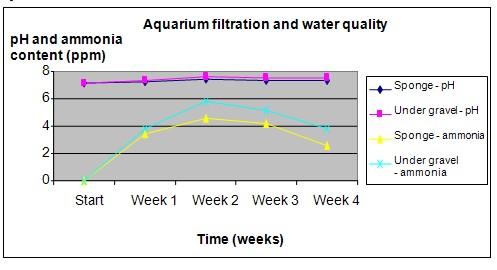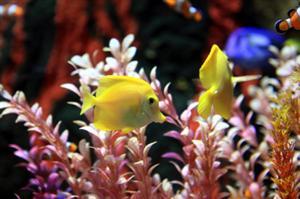| Complexity level: | 6 |
| Project cost ($): | 90 |
| Time required: | 1 day to prepare, 28 days for the science project experiment |
| Material availability: | Easily found |
| Safety concerns: | Basic safety requirements |
Hypothesis
Sponge aquarium filters are more effective than under-gravel filters.
Overview
Aquarium water filtration
All fish aquariums will require some kind of filtration system to maintain the quality of the water inside the fish tank. This is because the fishes continuously produce waste inside the water. The filter will help remove the dirt particles, ammonia and nitrites from the water. There are 3 common classes of filters for aquariums – biological, mechanical and chemical.
Biological filtration involves growing some useful bacteria in the filter. The bacteria will help to convert the ammonia in the water into nitrites, which is safer. Another group of bacteria will later convert the nitrites into nitrates, which are even less harmful. The ammonia in the water is produced by the fishes’ gills, urine and other decaying organic matter in the water.
Mechanical filtration helps to remove waste particles by pumping the water through a porous material or sponge. The dirt particles will get trapped in the filter. This filter will require regular cleaning and replacement of the sponge.
Chemical filtration involves passing the water through a carbon filter in order to remove the materials that are dissolved in the water. Odors, ammonia and some toxic metals can be removed by this process.
Scientific Terms
Materials
The materials required for this science fair project:
- 6 gold fish
- 2 fish aquariums
- Fish food
- Enough water to fill the aquariums
- 1 sponge filtration system
- 1 under gravel filtration system
- 1 freshwater test kit
Procedure
1. For this science fair project, the independent variable is the type of filtration system used – sponge filtration or under-gravel filtration. The dependent variable is the pH reading and the ammonia content of the water in the aquarium. This is determined by using a freshwater test kit . The constants (control variables) are the number of fishes in each tank, the types of fish used and their age/maturity, the size of the tank and the amount of fish food given daily.
2. The fish tanks are prepared by setting up the sponge filtration system and the under gravel filtration system in each of the aquariums. The aquariums are then filled with fresh water and the filtration systems are powered up . Three gold fishes are placed inside each aquarium.
3. Using the fresh water test kit, the pH readings of the water and the ammonia content of the water are taken. The readings are recorded .
4. The fishes are fed once a day with equal amounts of food in each tank. For the next 4 weeks, the water in the tank and the filters will not be changed.
5. Once every week, for the next 4 weeks, the levels of ammonia and the pH of the water in the aquarium are measured using the freshwater test kit..

Results
It was observed that the sponge filtration system effectively maintained a lower pH value and also a lower ammonia content in the water, compared to the aquarium using the under-gravel filtration system - throughout the 4 weeks.
|
Aquarium filter and test |
Measurement of water pH and ammonia content (ppm) |
||||
|
Start |
Week 1 |
Week 2 |
Week 3 |
Week 4 |
|
|
Sponge - pH |
7.1 |
7.2 |
7.4 |
7.3 |
7.3 |
|
Under gravel - pH |
7.1 |
7.3 |
7.6 |
7.5 |
7.5 |
|
Sponge - ammonia |
0 |
3.4 |
4.6 |
4.2 |
2.6 |
|
Under gravel - ammonia |
0 |
3.8 |
5.8 |
5.1 |
3.8 |
The graph below represents the results of our science project experiment.

Conclusion
Our hypothesis has been proven to be correct - sponge aquarium filters are more effective than under-gravel filters.
Aquariums at least require a mechanical and a biological filtration system to keep the water inside the tank healthy and conducive for fish to live. The under-gravel filter and the sponge filter are able to perform both biological and mechanical filtration functions.
Also consider
To improve the reliability and accuracy of our results, a larger sample of participants should be used.
This science fair project may be repeated, this time, with different types of filters like the power filter or canister filter.
Modify the science project experiment, using different types or different quantities of fish in each aquarium.
References
Selecting a filter - http://freshaquarium.about.com/cs/beginnerinfo/l/aa110998.htm
Aquarium filter and fish tank filtration - http://www.fishlore.com/Filtration.htm

